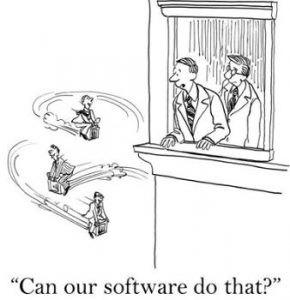The success of BI is in some ways its undoing. Such is the increasing demand that BI teams are struggling under an avalanche of unmet BI needs. In an effort to lighten the load, many are ’embracing a self-service mantra.’ Those in anticipation of a quick fix for their problems soon learn their error.
 While self-service aims to make BI experiences more robust, BI teams should not consider themselves off the hook. There is a vital role: the enablement of a functioning system. Kimberley Nevala, writing for Network World, states that a well-considered strategy must address the following:
While self-service aims to make BI experiences more robust, BI teams should not consider themselves off the hook. There is a vital role: the enablement of a functioning system. Kimberley Nevala, writing for Network World, states that a well-considered strategy must address the following:
One size doesn’t fit all: BI users all have different needs. The executive might need ‘access to corporate scores on an iPad,’ while an emerging data scientist might need access to more ‘robust discovery tools and broad data sets.’ Different levels of access, capabilities and solutions need to be considered.
1. Unique SLAs: Each user will have their own expectations and requirements for support. Differentiated service-level agreements and engagement models should be the outcome.
2. A blank slate is a bad slate: Self-service is seen at its best when users are given solid foundations. Provide users with direction by addressing the ‘most common metrics, report dimensions, analysis and/or data.’ In this way, users can modify the existing options to suit their needs.
3. Enablement beats development: Self-service has shifted the BI paradigm from delivery of polished information in a ‘widget’ to the delivery of datasets and tools in order to exploit the data themselves. This requires ongoing training, however, in the form of regular and frequent training sessions.
4. It’s communal: Collaboration is exceedingly important to the viability of self-service. A good community creates its own support system, promoting and harnessing the power of this collective. Features are provided allowing users to:
- Vet data and analysis among themselves
- Develop a common understanding of shared datasets
- Solicit input on the cause and potential impact of key findings
- Capture and track the effectiveness of actions taken based on reported findings.
5. It’s a balancing act: Any self-service environment can quickly become little more than a confusing mess of data, meaningless reports and misdirected analysis. The right balance needs to be maintained between good governance relative to the sharing and publication of information. This is particularly so for official reporting and compliance data.
Implemented properly, self-service can extend the visibility, value and adoption of BI and analytic solutions. If this is done wrong, however, an already disgruntled and overwhelmed user community can become exasperated.
Big Data and related technologies – from data warehousing to analytics and business intelligence (BI) – are transforming the business world. Big Data is not simply big: Gartner defines it as “high-volume, high-velocity and high-variety information assets.” Managing these assets to generate the fourth “V” – value – is a challenge. Many excellent solutions are on the market, but they must be matched to specific needs. At GRT Corporation our focus is on providing value to the business customer.



